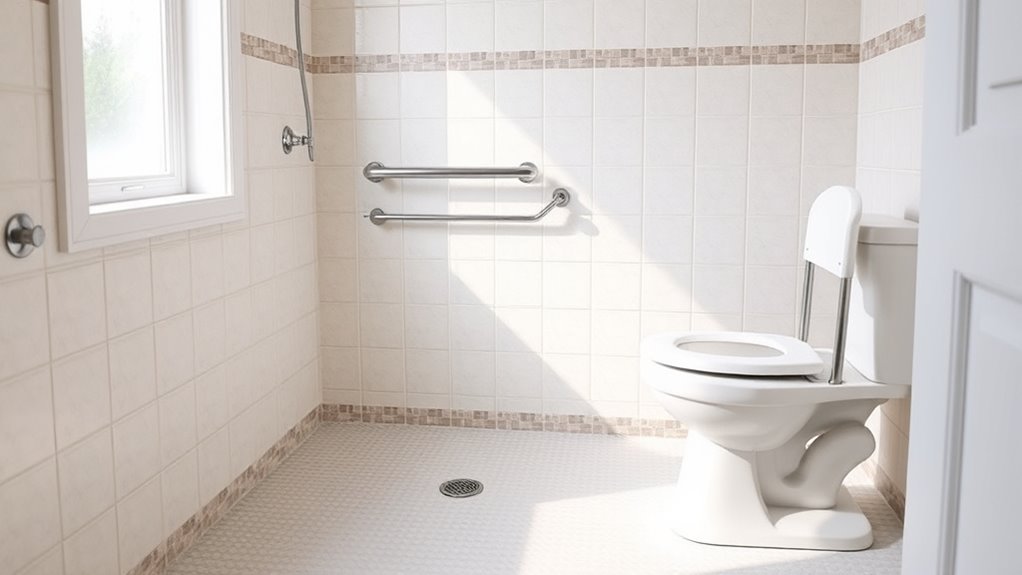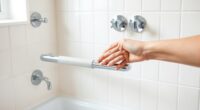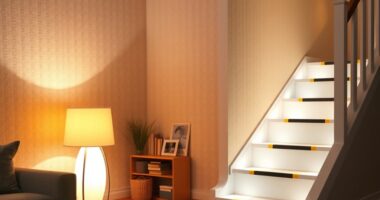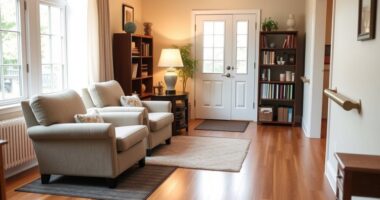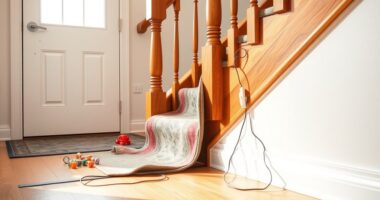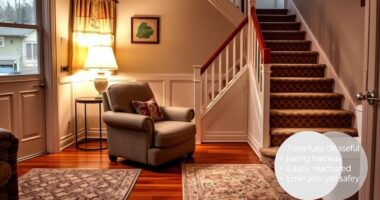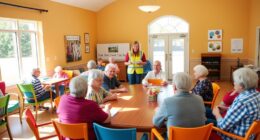To prevent slips and falls in your bathroom, assess hazards like loose tiles or clutter and make necessary adjustments. Install non-slip flooring, grab bars, and supportive seats, especially near the toilet and shower. Improve lighting with bright fixtures and nightlights to boost visibility. Keep the space organized and clutter-free, and regularly check safety devices for wear. Continuing with these tips can help you create a safer bathroom environment for seniors.
Key Takeaways
- Install grab bars and non-slip mats to provide stability and reduce slipping hazards in the bathroom.
- Ensure proper lighting, including nightlights, to improve visibility during nighttime visits.
- Keep pathways clutter-free and well-lit, removing loose tiles or objects that could cause tripping.
- Use supportive devices like shower seats and maintain safety equipment in good condition.
- Educate seniors on bathroom safety practices, including drying floors and using grab bars correctly.
Assessing Bathroom Hazards and Making Necessary Adjustments
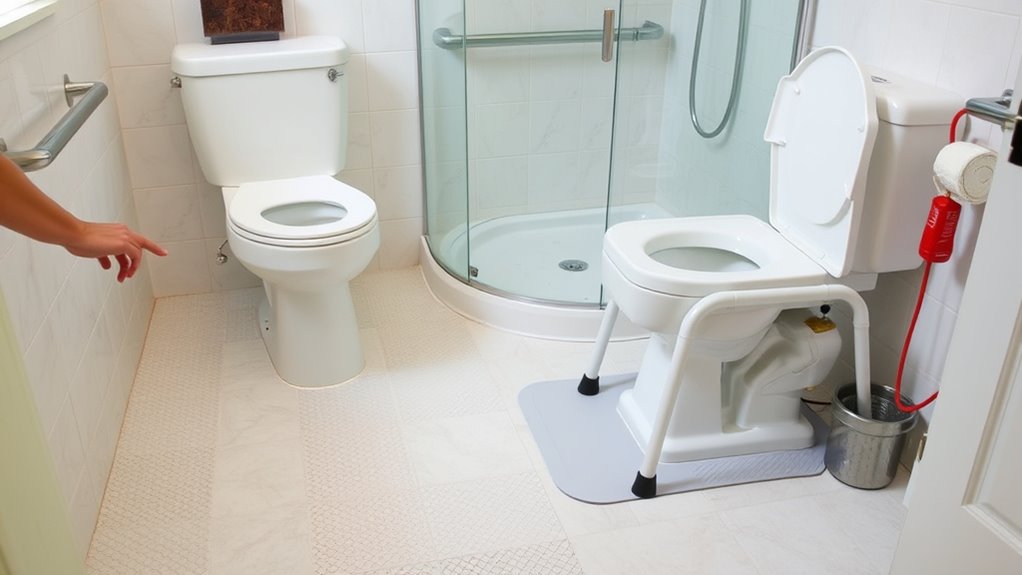
To prevent falls and injuries, it’s vital to carefully evaluate your bathroom for hazards. Start by inspecting your bathtub; consider bathtub modifications like installing grab bars, a bath seat, or a walk-in tub to reduce slipping risks. Good bathroom ventilation is also essential, as excess moisture can create slippery surfaces and mold, which pose health hazards. Make sure your bathroom has proper airflow by installing an exhaust fan or opening windows regularly. Check for uneven flooring, loose tiles, or clutter that could cause trips. Keep pathways clear and well-lit. These adjustments make your bathroom safer by addressing common hazards, helping you maintain independence and avoid accidental falls. Regularly reassess your space and update safety features as needed.
Installing Non-Slip Flooring and Mats
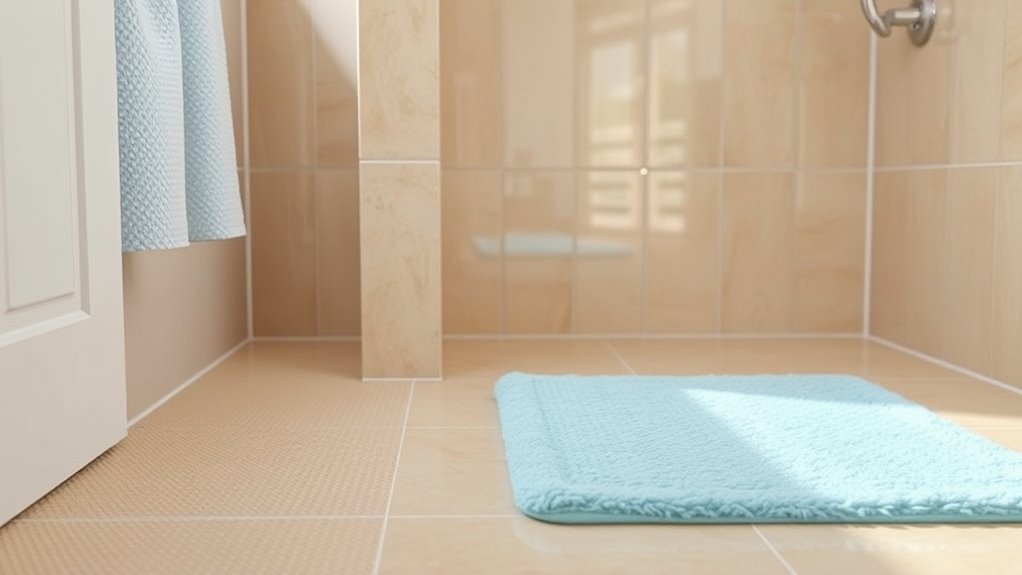
Choosing the right flooring and mats can make a big difference in bathroom safety. You should opt for durable materials that resist slipping and wear over time. Additionally, using absorbent mats helps prevent water from creating slippery spots on the floor. Regularly inspecting and replacing worn mats helps maintain a safe environment. Safety regulations should be followed when selecting and installing bathroom flooring to ensure compliance with local standards. Incorporating self-watering plant pots with non-slip bases can also help prevent water spills and reduce slip hazards in bathrooms. Understanding relationship patterns can also inform the placement of mats and flooring choices to prevent common accident zones.
Choose Durable Materials
Selecting durable materials is essential for guaranteeing bathroom safety for seniors. Opt for slip resistant tiles to reduce the risk of falls on wet surfaces, especially in high-traffic areas. Choose waterproof countertops to prevent water damage and maintain a sturdy surface. When selecting materials, consider these key points:
- Use slip resistant tiles for floors to enhance grip.
- Pick waterproof countertops to resist moisture and spills.
- Avoid slippery surfaces like polished stone or glazed ceramics.
- Ensure all materials are easy to clean and maintain for long-term safety.
- Be aware of credit card security measures to protect personal information when making online purchases for bathroom upgrades.
- Incorporating exploration in your planning can lead to discovering innovative safety solutions tailored to your needs. Additionally, researching proper installation techniques can ensure these materials remain slip-resistant and durable over time, especially considering material properties that influence safety and longevity. Considering proper maintenance practices can further extend the lifespan of these safety features and ensure continued slip resistance.
Use Absorbent Mats
Installing absorbent mats in your bathroom can considerably improve safety by minimizing the risk of slips and falls. These mats help with slip prevention by providing a textured, non-slip surface, especially in wet areas. Look for mats made from absorbent textiles that quickly soak up water, keeping the floor dry and reducing hazards. Place them strategically outside the shower or bathtub, and near the sink, to catch drips and excess moisture. Ensure the mats have a secure grip, like rubber backing, to prevent slipping when stepped on. Regularly wash and replace mats to maintain their absorbency and grip. Using absorbent mats is a simple yet effective way to create a safer bathroom environment, giving you added confidence and peace of mind. Incorporating proper bathroom maintenance practices can further enhance safety and prevent accidents, just as proper Volkswagen Tuning ensures vehicle performance and safety. Additionally, choosing mats with antimicrobial properties can help reduce mold and bacteria buildup, contributing to a healthier bathroom space.
Adding Grab Bars in Key Areas

Adding grab bars in key areas of your bathroom can considerably reduce the risk of slips and falls. Proper grab bar placement enhances safety and accessibility improvements. To maximize their effectiveness, consider these tips:
- Install grab bars near the toilet, ensuring they’re within easy reach.
- Place them inside and outside the shower or bathtub for stability when entering or exiting.
- Position grab bars at a height that allows a comfortable grip, typically about 33-36 inches from the floor.
- Use sturdy, slip-resistant bars anchored into wall studs for maximum support.
- Understanding AI’s role in safety innovations can inform smarter design choices for future bathroom safety solutions. Incorporating smart technology into grab bar design, such as sensors or alerts, can further enhance safety and responsiveness. Additionally, regional resources and tools can provide guidance on proper installation and safety standards to ensure optimal protection. Considering Kia Tuning techniques can inspire innovative ways to customize safety features for enhanced user confidence and support.
Ensuring Proper Lighting Throughout the Bathroom
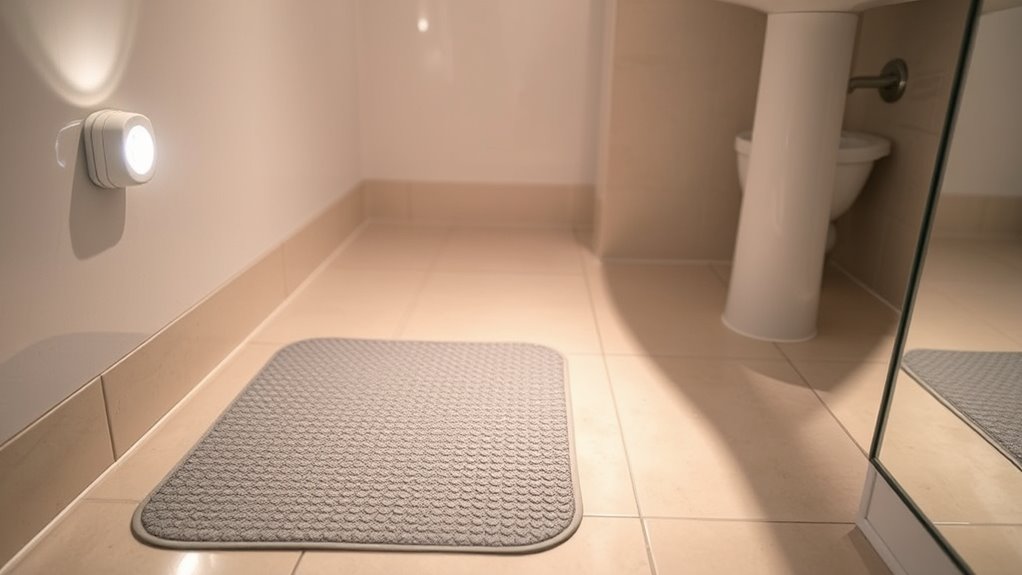
Proper lighting is essential to keep your bathroom safe and easy to navigate. Make sure you have adequate overhead lighting to brighten the entire space, and consider night-time illumination options like nightlights or motion-activated lights. These simple upgrades can help prevent accidents and give you peace of mind. Additionally, incorporating AI-powered safety technologies can further monitor and improve bathroom safety for seniors. As with literary humor that can lighten serious conversations, thoughtful lighting can brighten your safety measures and make your bathroom a more welcoming space. Incorporating home safety improvements such as non-slip mats and grab bars can further enhance safety in conjunction with proper lighting. Leveraging automation’s role in business intelligence principles, smart lighting systems can adapt to the time of day or individual needs, providing optimal illumination and reducing hazards.
Adequate Overhead Lighting
Adequate overhead lighting is essential for seniors to navigate the bathroom safely and confidently. Proper bathroom illumination reduces shadows and brightens key areas, making it easier to see obstacles and prevent falls. To optimize your overhead lighting, consider these steps:
- Install bright, energy-efficient bulbs with high lumen output for clear visibility.
- Choose fixtures with diffusers to eliminate harsh glare.
- Position overhead lights centrally to evenly distribute light across the space.
- Replace dim or flickering bulbs promptly to maintain consistent bathroom illumination.
Nighttime Illumination Options
To guarantee safe bathroom use at night, you need reliable lighting that turns on easily and provides enough brightness without causing glare. Motion sensors are an excellent option, as they automatically activate when you enter the bathroom, eliminating the need to fumble for switches. Nightlights are also effective, especially when placed strategically near the toilet, sink, or along the floor, offering gentle illumination that guides you safely in the dark. Choose energy-efficient LED nightlights for long-lasting, consistent brightness. Combining motion sensors with nightlights creates a seamless, hands-free lighting system that reduces the risk of slips and falls during nighttime visits. Proper illumination ensures you can see clearly without startling glare or shadows, making bathroom trips safer and more comfortable. Research shows that security systems can also be an effective way to increase overall safety in your home, including your bathroom area. Incorporating proper lighting solutions can significantly enhance safety and peace of mind during nighttime bathroom visits. Additionally, selecting lighting options that minimize glare and shadows can further improve visibility and safety.
Using Shower and Tub Seats for Stability
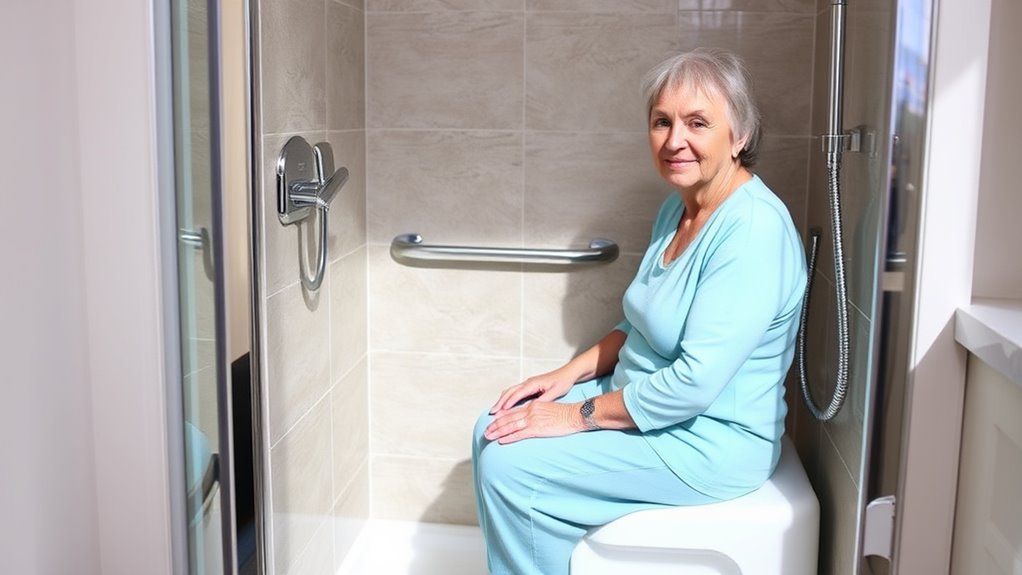
Using shower and tub seats can markedly improve stability and reduce the risk of falls during bathing. They provide a secure seat, making you feel more confident and comfortable. To maximize benefits, consider the following:
- Choose a shower seat with good shower seat comfort to prevent discomfort during use.
- Ensure the tub seat stability by selecting one with non-slip legs or suction cups.
- Adjust the height so your feet rest flat on the floor, promoting better balance.
- Use a seat with armrests, offering extra support when transferring or standing.
Keeping Frequently Used Items Within Reach
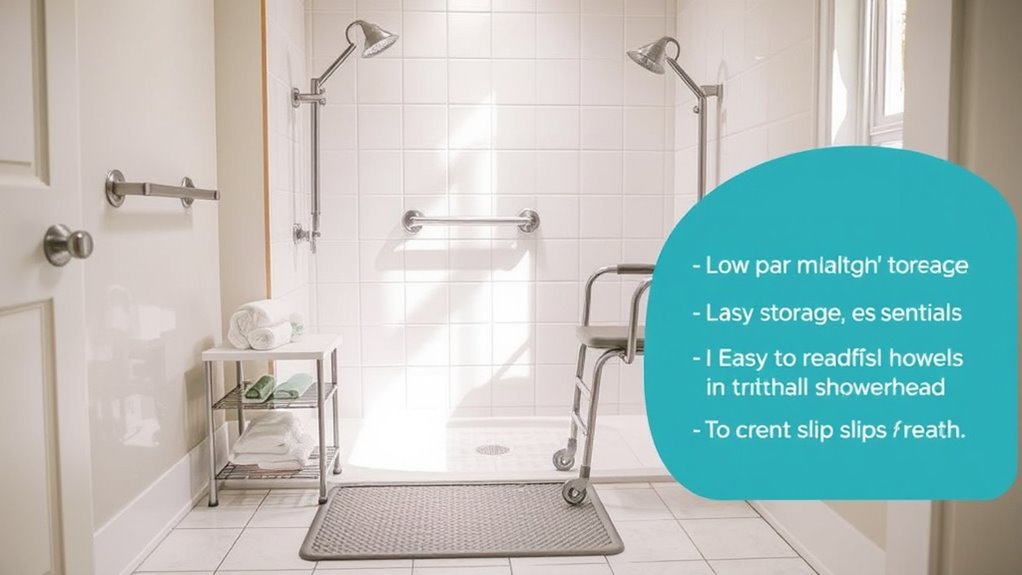
Keeping frequently used items within reach can prevent unnecessary stretching or bending that might lead to falls. Place grab bars near the shower, tub, and toilet to provide support when reaching for items or standing up. Proper grab bar placement ensures you can steady yourself easily, reducing the risk of slips. Also, make sure faucet accessibility by choosing lever handles or single-handle fixtures that are easy to operate, even with limited grip strength. Store items like soap, shampoo, and towels on shelves or in accessible containers close to where you use them most. This minimizes movement and keeps everything within a safe, comfortable reach. Organizing your bathroom this way helps you stay stable and reduces the chance of accidents.
Maintaining Clear and Clutter-Free Spaces
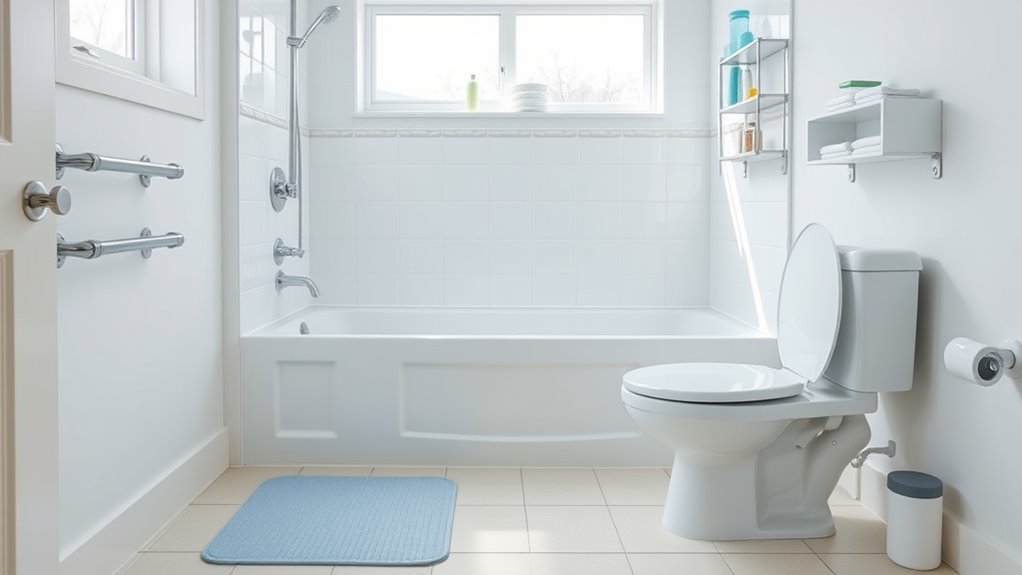
Cluttered bathroom spaces increase the risk of slips and falls by creating obstacles that can trip or cause imbalance. To maintain clear and clutter-free spaces, consider these tips:
- Use storage solutions like baskets, shelves, and cabinets to organize toiletries and cleaning supplies.
- Avoid leaving towels, clothes, or bottles on the floor or around the sink.
- Keep decorative accessories minimal to reduce unnecessary clutter.
- Regularly clean and declutter your bathroom to make sure pathways stay open and safe.
Choosing Safe and Supportive Bathroom Fixtures
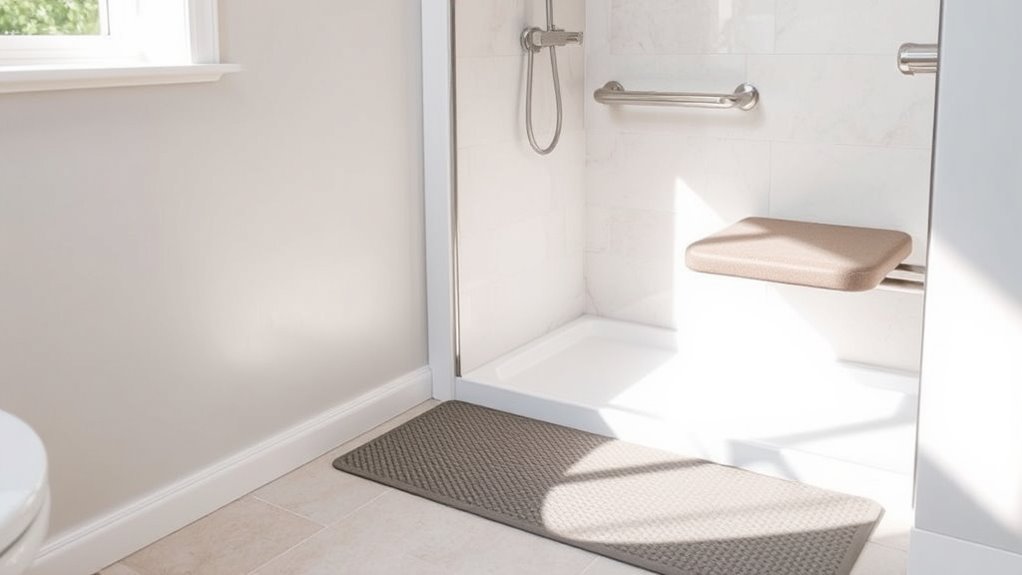
Choosing bathroom fixtures that prioritize safety and support can substantially reduce the risk of falls and injuries. When considering bathtub installation, opt for walk-in tubs or those with built-in grab bars to make entry and exit easier and safer. Non-slip surfaces inside the tub can prevent slipping during use. For sink accessibility, select models with lever handles instead of knobs, making them easier to operate if strength or dexterity is limited. Confirm the sink height is appropriate for easy reach without excessive bending. Installing fixtures at the right height and with supportive features can make daily routines safer and more comfortable. These simple adjustments can significantly lower fall risks and help you maintain independence in your bathroom.
Regularly Checking and Maintaining Safety Equipment

Regularly inspecting and maintaining your safety equipment is essential to guarantee it functions properly when you need it most. Performing regular inspections ensures your safety equipment remains effective and reliable. Here are four key steps:
- Check for wear and tear on grab bars, ensuring they’re secure and stable.
- Test non-slip mats and surfaces to confirm they still provide traction.
- Examine shower chairs and other support devices for signs of deterioration.
- Replace or repair damaged safety equipment immediately.
Educating Seniors on Safe Bathroom Practices
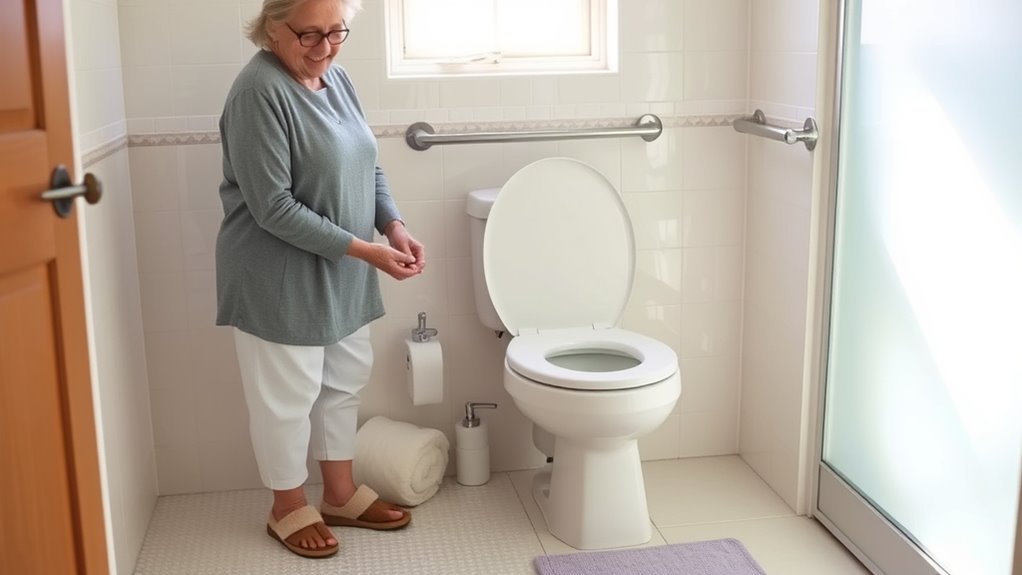
Educating seniors on safe bathroom practices is essential for preventing accidents and promoting independence. When seniors understand bathroom safety, they’re better equipped to avoid hazards and maintain confidence. You should emphasize the importance of using grab bars, non-slip mats, and proper lighting. Encourage awareness of common risks and how to prevent them. To enhance senior awareness, consider visual aids or simple checklists to reinforce safety habits. Here’s a quick guide:
| Safety Measure | Purpose |
|---|---|
| Install grab bars | Prevent falls during transfers |
| Keep the floor dry | Reduce slip risk |
| Use proper lighting | Improve visibility |
Fostering education helps seniors take control of their bathroom safety, reducing fall risks and supporting independence.
Frequently Asked Questions
How Can I Make My Bathroom More Accessible for Seniors?
To make your bathroom more accessible for seniors, start by installing bathroom grab bars near the shower and toilet for added support. Use non-slip mats in the shower and on the bathroom floor to prevent slips. Guarantee pathways are clear of clutter, and consider a shower seat if needed. These simple adjustments can boost safety and independence, making the bathroom a more comfortable space for seniors.
Are There Specific Colors or Lighting Recommendations for Safety?
You should focus on color contrast and lighting brightness to enhance bathroom safety. Use contrasting colors for floors and walls to help you distinguish edges and potential hazards easily. Opt for bright, well-distributed lighting to eliminate shadows and improve visibility. Avoid harsh glare, but guarantee the room is well-lit. Proper lighting and contrasting colors work together to reduce accidents and make your bathroom safer and more comfortable.
What Are Some Cost-Effective Ways to Improve Bathroom Safety?
To improve bathroom safety affordably, focus on simple DIY modifications like adding non-slip mats and grab bars. You can also upgrade lighting with brighter, energy-efficient bulbs to enhance visibility. Consider affordable upgrades such as installing a shower chair or adjusting the toilet height. These cost-effective solutions reduce the risk of slips and falls, making your bathroom safer without breaking the bank. Small changes can make a big difference in safety.
How Often Should Safety Equipment Be Inspected or Replaced?
You should perform monthly inspections of your safety equipment, checking for wear and tear or any damage. Follow the replacement guidelines provided by the manufacturer, which typically recommend replacing items like grab bars, mats, or non-slip surfaces every 1-2 years or sooner if damaged. Regularly maintaining and replacing equipment guarantees it functions properly, reducing the risk of slips and falls. Staying proactive protects your safety and prolongs the effectiveness of your safety measures.
Can Technology Assist in Preventing Bathroom Falls?
Technology can definitely help prevent bathroom falls. Smart alarms alert you if you’ve been in the bathroom too long or if there’s a sudden fall, while motion sensors detect movement and can trigger lights or alerts. These devices increase safety by providing immediate notifications and encouraging prompt assistance. By integrating smart alarms and motion sensors, you make your bathroom safer and reduce the risk of dangerous slips and falls.
Conclusion
By taking these simple steps, you’ll create a safer bathroom that feels more comfortable and confident. Sometimes, a small change like adding a grab bar or keeping the floor dry can prevent a fall when you least expect it. It’s funny how these little adjustments, made just in time, can turn your bathroom into a secure space where you can relax without worry. Safety and comfort go hand in hand—making every visit a little easier and a lot safer.
